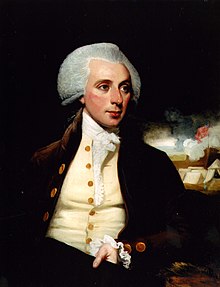William Stephens Smith
William Stephens Smith | |
|---|---|
 1786 portrait of Smith by Mather Brown | |
| Member of the U.S. House of Representatives from New York's 17th district | |
| In office March 4, 1813 – March 3, 1815 | |
| Preceded by | None; district established |
| Succeeded by | Westel Willoughby Jr. |
| Personal details | |
| Born | November 8, 1755 Federalist |
| Spouse | |
| Children | 4 |
| Residence | Lebanon, New York |
| Alma mater | College of New Jersey |
| Profession | Military officer, government official |
| Signature | |
William Stephens Smith (November 8, 1755 – June 10, 1816) was a United States representative from New York. He married Abigail "Nabby" Adams, the daughter of President John Adams, and so was a brother-in-law of President John Quincy Adams and an uncle of Charles Francis Adams Sr.
Early life
Born in Suffolk County, New York, on Long Island, he graduated from the College of New Jersey (now Princeton University) in 1774 and studied law for a short time.[citation needed]
American Revolutionary War
Smith served in the
Later life
This section needs additional citations for verification. (July 2023) |
Smith was secretary of the Legation at London in 1784. While there, he met and courted John Adams's daughter, Abigail, whom he married in 1786.[2] He returned to America in 1788.
He was appointed by President
Along with General Francisco de Miranda, Colonel Smith raised private funds, procured weapons, and recruited soldiers of fortune to liberate Venezuela from Spanish colonial rule. That action was inspired by Smith's renewal of acquaintance with Miranda, whom Smith had first met when he was John Adams's secretary in London. On February 2, 1806, a force of 200 filibusters, including Smith's son William Steuben, set sail to Venezuela on a chartered merchant vessel, the Leander, armored by Samuel G. Ogden.
In
General Miranda decided to land in La Vela de Coro and the squadron anchored there on August 1, carrying a flag that Miranda had designed, which later became the flag of modern Venezuela. Nevertheless, the local support that he had hoped for failed to materialize when the fighting started. Much of the local population joined the Spanish against the mercenaries and August 13, Miranda hastily retreated to Aruba and Trinidad, where he left the Leander to avoid the prosecution of Spanish fleet.
In the aftermath of the failed expedition, Colonel Smith and Ogden were indicted by a federal grand jury in New York for violating the
In 1807, Smith moved to
The Secretary of State of New York initially issued his credentials of election to the 14th United States Congress, but Smith did not claim the seat. Some of the ballots had been returned for "Westel Willoughby," without the "Jr.", and so Smith initially appeared to have a majority. Smith declined to challenge the results, and on December 15, 1815, at the start of the first session of the 14th Congress, the House voted that Willoughby was entitled to the seat.
Death
Smith died in Smith Valley, Lebanon, New York in 1816. He is interred in West Hill Cemetery in Sherburne, New York.
Family

William Stephens Smith was the son of John Smith, a wealthy New York City merchant, and Margaret Stephens. His siblings included a sister, Sally, who was married to Charles Adams, the son of John Adams and brother of John Quincy Adams. Sally's daughter, Abigail Louisa Smith, Adams married the banker and philosopher Alexander Bryan Johnson; their son, William's grandnephew, Alexander Smith Johnson, became a judge.
He and his wife, Abigail Adams, had four children:
- William Steuben Smith (1787—1850)
- John Adams Smith (1788—1854)
- Thomas Hollis Smith (1790—1791)
- Caroline Amelia Smith (1795—1852) – married John Peter DeWint of Fishkill-on-Hudson
| ||||||||||||||||||||||||||||||||||||||||||||||||||||||||||||||||||||||||||||||||||||||||||||||||||||||||||||||||||||||||||||||||||||||||||||||||||||||||||||||||||||||||||||||||||||||||||||||||||||||||||||||||||||||||||||||||||||||||||||||||||||||||||||||||||||||||||||||||||||||||||||||||||||||||||||||||||||||||||||||||||||||||||||||||||||||||||||||||||||||||||||||||||||||||||||||||||||||||||||||||||||||||||||||||||||||||||||||||||||||||||||||||||||||||||||||||||||||||||||||||||||||||||||||||||||||||||||||||||||||
In popular culture
- Smith was portrayed by Andrew Scott in the 2008 miniseries, John Adams.
- Incidents in the Life of John Edsall is an autobiographical memoir published in Catskill, New York, in 1831. John Edsall (1788 – after 1850) was an illiterate American sailor who participated in several historically significant voyages and events. Edsall's seafaring adventures began at age 18 when he was inveigled into joining the filibustering expedition of General Francisco de Miranda to liberate Venezuela in 1806.
References
- ^ (USMS), U.S. Marshals Service. "U.S. Marshals Service". www.usmarshals.gov. Retrieved April 27, 2018.
- ISBN 0-19-503874-6
- ^ Edsall, John; P., J. D. (April 27, 2018). "Incidents in the life of John Edsall". Catskill [N.Y.] Pub. for the author. Retrieved April 27, 2018 – via Internet Archive.
- ^ Ross, Shelley Washington Babylon Allison & Busby (1989).
- United States Congress. "William Stephens Smith (id: S000638)". Biographical Directory of the United States Congress.
- Raymond, Marcius Denison. Colonel William Stephens Smith, New, York Genealogical and Historical Record 25, 4 (1894): 153-61.
External links
 Media related to William Stephens Smith at Wikimedia Commons
Media related to William Stephens Smith at Wikimedia Commons- Full text archive of 'General Miranda's Expedition', from the Atlantic Monthly May 1860
- General Miranda's Expedition an 1860 account of the Leander affair https://www.fulltextarchive.com/page/Atlantic-Monthly-Vol-5-No-31-May-18603/#p71
- William Stephens Smith at Find a Grave
